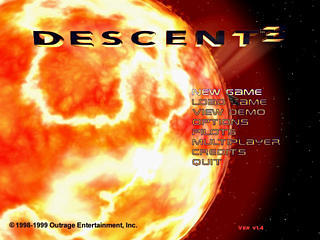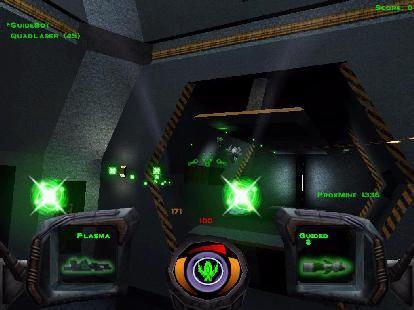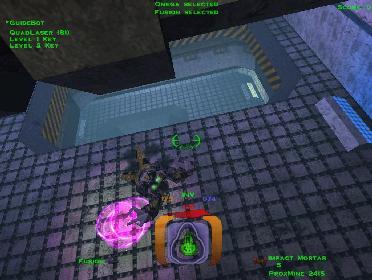
Kudos to the fine folks at Outrage and Loki for getting the latest Descent into our sweaty little hands.

Manufacturer: Loki Entertainment Software
E-Mail: sales@lokigames.com
Price: $24.95 US
Reviewer: J. Neil Doane
This month's review is of yet another great Loki game. Honest folks, we're not playing favorites here; Loki is just so forthcoming and has so many store-shelf titles out there right now it's inevitable we're going to have a bit of a Loki deluge from time to time. We do have some other great non-Loki titles in the pipe and will be spending some time on Linux's noncommercial gaming as well, we promise!
For now, I meant it when I said that this is a great game; this game rocks. Descent3 is the first Descent version to make it to Linux, and it looks like we're getting the best installment in the series so far. Kudos to the fine folks at Outrage and Loki for getting the latest Descent into our sweaty little hands. Some of us still remember the awe we felt when we played the original Descent for the first time, twisting through subterranean mineshafts, floating weightlessly in space and the dizzyingly true 3-D maneuvering possible from Descent's six-way motion control system. The original Descent's biggest issues were its repetitive nature and simple plotlines. Even its successor, Descent2, saw little improvement on these fronts, mainly adding support for new hardware, some improved game play and some new weapons to enjoy. Descent3 finally gets it right; this game has both an interesting story and unique levels with diverse, multiple goals, yet manages it all without straying too much from the basic feel players have come to expect from Descent-series games.
The story is not too complex, but it's entertaining and well written (at last). The visually stunning introductory movie and the first premission cut-scene movie are each five full minutes of completely 3-D modeled plot development. Descent3 essentially takes up right where its predecessor left off: you're unconscious and adrift in space after the explosion that rocked your world at the end of the Descent2. At the last moment, as you and your ship plunge helplessly to your doom into a solar corona, you're rescued by some new friends. They reveal that your old employer, the PTMC, has been doing some rather nasty stuff, such as developing weird nanotech viruses designed to turn mining robots into bloodthirsty military tools. Worse, they're apparently responsible for sabotaging your ship and attempting to kill you! (Okay, it isn't Herman Melville, but it's a good enough story to keep you interested.) The rest of the game is basically about flying around in your new spaceships (you eventually get three), attempting to subvert the PTMC's plans, rescuing key detectors involved in the virus project, exposing the PTMC's evilness to the world and, more or less, opening up a proverbial can of Material Defender-style whoop-ass on your ex-employer and would-be assassin. The story line unfolds fluidly through the use of 3-D modeled cut-scenes and radio transmissions. It is actually quite compelling at times and has some unexpected twists. Though Descent3 is still a game that could be played with no prior exposure to the plot, it is now good enough to be engaging and fun to watch unfold.

Figure 1. The Plasma Cannon: when you absolutely, positively gotta wipe out every PTMC robot in the room.
Combining the ease of movement in a first-person shooter with the directional freedom of a spaceship is something Descent has excelled at from the beginning. The task is not without cost, however, and many players find that keyboard-only control is extremely less effective than using a joystick. There are three axes of motion and three directions of travel to deal with, so coordinating the full use of all motion controls while navigating and fighting unfriendly robots in tight underground passageways is often a rough proposition.
The game itself is a series of missions, 15 in all, each with its own unique objectives. Though the “find keys to open doors to get to goal” motif is still present to at least some degree in most levels, most have several challenging sub-goals to reach, as well as occasional puzzles that must be solved in-game, some of which can be quite challenging. Your enemy's artificial intelligence is pretty high-quality stuff and is a major improvement from past Descent versions. You'll find that they attack in groups and use strategy (often falling back when in danger to regroup), communicate with each other and announce your presence to other robots in your general area (which typically brings in the cavalry to cause you more headaches, some of which will sneak around behind corners and lurk in waiting for you to pass by, while others will get right in your face, or worse, sneak up right behind you). Thankfully, Descent3 comes with ten brand-new weapons for you to use on these little twerps. Another of Outrage's triumphs, their new “Fusion” rendering engine, allows another new facet to Descent's levels: outdoor missions. No longer are you continuously trapped in the claustrophobic depths of some darkened mineshaft; now you can soar in the skies above the extraterrestrial surface. The underground levels themselves are well designed, varied in setting, often incredibly complex in layout and generally look spectacular. All the levels are rather gargantuan and complex; with only 15 total levels in the single-player mode, each tends to consume a significant amount of time and effort to complete. Luckily, in Descent3, you're not alone down there....
Your little buddy from Descent2 is back! Descent3 also gives its pilots the ability to use a “guidebot”. Guidebots are small robots who accompany you down in the tunnels, are carried by your ship and act as roving robotic assistants. In times of need, you can launch your guidebot and ask him to help you do any number of things, from leading the way out of the seemingly endless maze of tunnels in order to help you find your next goal (patiently waiting for you to follow it along) to putting out fires or showing you the way to the next enemy robot. Occasionally, the guidebot gets a bit confused or forgets the next goal, and from time to time, he gets stuck in weird places, but he is often an invaluable sidekick.
Descent3's audio/video quality is truly inspired: the graphics are stunning; the environment can be manipulated and destroyed; the special effects sounds are realistic and crystal clear (and do much to provide the perfect level of ambient noise in the tunnels) and even the background music sounds not only good enough to leave turned on, but good enough to turn up. My only issue with Descent3's OpenAL-accelerated sound is that it made me wish I had larger speakers and more forgiving neighbors.
Descent3's multiplayer support is, well, phenomenal. You have nine types of multiplayer games to choose from, ranging from the favorites like “Capture the Flag” and “Deathmatch” (Anarchy mode) to the much less frequently seen (but often missed) “Cooperative” mode. The “Monster Ball” mode is kind of like a soccer game with spaceships. You can play in TCP/IP-based mode for direct connections, or if you're looking for a game, you can connect to Outrage's Parallax Online (PXO) gaming network and join a game in progress. The descent3 binary can also be run by itself as a standalone game server for the truly hardcore who want to host their own dedicated Descent3 server.

Figure 2. Take down the HUD for those fights when maximum visibility is critical.
Descent3's installation footprint can get hefty (up to 1GB), but Loki's installer includes options for a much smaller install, mainly done by leaving the movies on CD. The game's hardware requirements are pretty low for the intensity of game play offered. Loki recommends only a 300MHz CPU (and even lists 200MHz as the bare minimum) and 64MB of RAM. One pitfall that Loki doesn't mention is that if you leave the movies on CD, you might want to consider a slightly faster CD-ROM than the 6x minimum recommended by Loki; my older 8x drive was choking and coughing in several of the more intense movie scenes. Software requirements include the usual Loki list: Linux kernel 2.2.x and Glibc 2.1 and, of course, for network play you'll need TCP/IP support and an internet or LAN connection.
One item on Descent3's minimum equipment list is a 3-D accelerator card. Several card options are supported and have been tested, including most of the more popular 3-Dfx Voodoo series (by way of a nice dedicated Glide renderer), the Matrox G200/G400-series cards (by way of Utah-GLX and Mesa drivers) and NVIDIA cards supported by NVIDIA's OpenGL-endowed X server (in-game testing, this reviewer's GeForce GTS worked flawlessly). For a complete list of cards and drivers that have been tested with Descent3, it's probably best to check http://www.lokigames.com/ for the latest news.
Optional equipment for Descent3 includes the Rock'n Ride gaming chair available from http://www.rocknride.com/ (the coolness of which really defies description). Loki has even been kind enough to include detailed instructions on how to use the new Descent3: Mercenary expansion pack for Windows with the Linux version of Descent3. Very sweet.
Again, what can I say? This game is very entertaining, very well written, very well executed and extremely fun to play. The graphics are exceptional, the sound effects are clear and high-quality—even the music is great. The basic movement controls may be a bit complex but nothing that shouldn't be expected for the amount of control you have over your ship. The general game controls are simple, easy to operate and logically arranged. The multiplayer action is second to none, and the 3-D support is trouble-free. A truly excellent game; for the first-person shooter genre, this is one of the coolest titles out there.